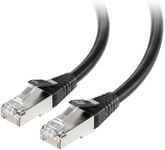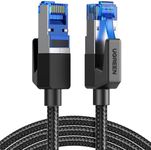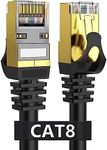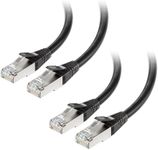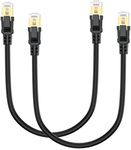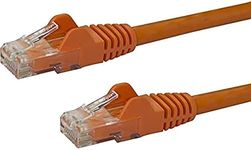Buying Guide for the Best Cat 8 Cables
When choosing Cat 8 cables, it's important to understand what makes them different from other Ethernet cables and how their features can impact your network performance. Cat 8 cables are designed for high-speed data transmission and are often used in environments where fast and reliable connections are crucial, such as data centers or for high-end home networking. To pick the best Cat 8 cable for your needs, you should focus on a few key specifications that determine how well the cable will perform in your specific setup.BandwidthBandwidth refers to the maximum amount of data that can be transmitted over the cable per second, usually measured in MHz. For Cat 8 cables, the bandwidth is typically up to 2000 MHz, which is much higher than previous categories. This is important because higher bandwidth allows for faster and more stable data transfer, especially when multiple devices are connected. If you have a network that requires handling a lot of data at once, such as streaming 4K videos or running servers, a higher bandwidth is beneficial. For basic home use, you may not need the full capacity, but it's good for future-proofing.
Maximum Data RateThe maximum data rate is the highest speed at which data can be transferred through the cable, usually measured in Gbps (gigabits per second). Cat 8 cables can support speeds up to 40 Gbps, which is significantly faster than most home internet connections. This spec is important if you need extremely fast data transfer between devices, such as in professional or enterprise environments. For most home users, even lower speeds are sufficient, but if you want the fastest possible connection for gaming, streaming, or large file transfers, a higher data rate is ideal.
ShieldingShielding refers to the protective layers around the wires inside the cable that help prevent interference from other electronic devices. Cat 8 cables usually have strong shielding, often labeled as S/FTP (Shielded Foiled Twisted Pair). This is important in environments with a lot of electronic noise, such as offices or near other cables, because it helps maintain a stable and reliable connection. If your cable will run near other electronics or in a busy area, look for well-shielded cables. For short runs in a quiet home environment, shielding is less critical but still adds reliability.
Cable LengthCable length is simply how long the cable is, and it can affect both convenience and performance. Cat 8 cables are typically recommended for runs up to 30 meters (about 100 feet) to maintain their top speed and reliability. Longer cables can experience signal loss, so it's best to choose a length that fits your setup without being excessively long. Measure the distance between your devices and pick a cable that covers it comfortably, allowing a little extra for routing around furniture or walls.
Connector TypeThe connector type refers to the ends of the cable that plug into your devices, most commonly RJ45 for Cat 8 cables. This is important because you need to make sure the cable will fit your network equipment, such as routers, switches, or computers. Almost all modern networking devices use RJ45 connectors, but it's always good to double-check compatibility, especially if you have specialized equipment.
Durability and Build QualityDurability and build quality refer to how well the cable is constructed, including the strength of the outer jacket and the quality of the connectors. This is important if the cable will be moved often, bent around corners, or used in areas where it might be stepped on. Look for cables with reinforced connectors and thick, flexible jackets if you need extra durability. For cables that will stay in one place, standard build quality is usually sufficient.

